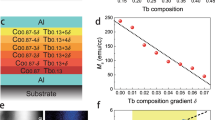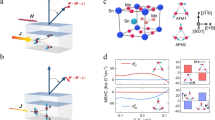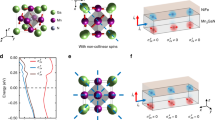Abstract
Spin–orbit torques arising from the spin–orbit coupling of non-magnetic heavy metals allow electrical switching of perpendicular magnetization. However, the switching is not purely electrical in laterally homogeneous structures. An extra in-plane magnetic field is indeed required to achieve deterministic switching, and this is detrimental for device applications. On the other hand, if antiferromagnets can generate spin–orbit torques, they may enable all-electrical deterministic switching because the desired magnetic field may be replaced by their exchange bias. Here we report sizeable spin–orbit torques in IrMn/CoFeB/MgO structures. The antiferromagnetic IrMn layer also supplies an in-plane exchange bias field, which enables all-electrical deterministic switching of perpendicular magnetization without any assistance from an external magnetic field. Together with sizeable spin–orbit torques, these features make antiferromagnets a promising candidate for future spintronic devices. We also show that the signs of the spin–orbit torques in various IrMn-based structures cannot be explained by existing theories and thus significant theoretical progress is required.
This is a preview of subscription content, access via your institution
Access options
Subscribe to this journal
Receive 12 print issues and online access
$259.00 per year
only $21.58 per issue
Buy this article
- Purchase on Springer Link
- Instant access to full article PDF
Prices may be subject to local taxes which are calculated during checkout




Similar content being viewed by others
References
Žutić, I., Fabian, J. & Das Sarma, S. Spintronics: fundamentals and applications. Rev. Mod. Phys. 76, 323–410 (2004).
Duine, R. Spintronics: an alternating alternative. Nature Mater. 10, 344–345 (2011).
Marti, X. et al. Room-temperature antiferromagnetic memory resistor. Nature Mater. 13, 367–374 (2014).
Satoh, T. et al. Spin oscillations in antiferromagnetic NiO triggered by circularly polarized light. Phys. Rev. Lett. 105, 077402 (2010).
Nogués, J. & Schuller, I. K. Exchange bias. J. Magn. Magn. Mater. 192, 203–232 (1999).
Núñez, A. S., Duine, R. A., Haney, P. & MacDonald, A. H. Theory of spin torques and giant magnetoresistance in antiferromagnetic metals. Phys. Rev. B 73, 214426 (2006).
Wei, Z. et al. Changing exchange bias in spin valves with an electric current. Phys. Rev. Lett. 98, 116603 (2007).
Urazhdin, S. & Anthony, N. Effect of polarized current on the magnetic state of an antiferromagnet. Phys. Rev. Lett. 99, 046602 (2007).
Park, B. G. et al. A spin-valve-like magnetoresistance of an antiferromagnet-based tunnel junction. Nature Mater. 10, 347–351 (2011).
Wang, Y. Y. et al. Room-temperature perpendicular exchange coupling and tunneling anisotropic magnetoresistance in an antiferromagnet-based tunnel junction. Phys. Rev. Lett. 109, 137201 (2012).
Mendes, J. B. S. et al. Large inverse spin Hall effect in the antiferromagnetic metal Ir20Mn80 . Phys. Rev. B 89, 140406(R) (2014).
Zhang, W. et al. Spin Hall effects in metallic antiferromagnets. Phys. Rev. Lett. 113, 196602 (2014).
Chen, H., Niu, Q. & MacDonald, A. H. Anomalous Hall effect arising from noncollinear antiferromagnetism. Phys. Rev. Lett. 112, 017205 (2014).
Miron, I. M. et al. Perpendicular switching of a single ferromagnetic layer induced by in-plane current injection. Nature 476, 189–193 (2011).
Liu, L., Lee, O. J., Gudmundsen, T. J., Ralph, D. C. & Buhrman, R. A. Current-induced switching of perpendicularly magnetized magnetic layers using spin torque from the spin Hall effect. Phys. Rev. Lett. 109, 096602 (2012).
Ryu, K.-S., Thomas, L., Yang, S.-H. & Parkin, S. Chiral spin torque at magnetic domain walls. Nature Nanotech. 8, 527–533 (2013).
Emori, S., Bauer, U., Ahn, S.-M., Martinez, E. & Beach, G. S. D. Current-driven dynamics of chiral ferromagnetic domain walls. Nature Mater. 12, 611–616 (2013).
Yu, G. et al. Switching of perpendicular magnetization by spin-orbit torques in the absence of external magnetic fields. Nature Nanotech. 9, 548–554 (2014).
Kim, J. et al. Layer thickness dependence of the current-induced effective field vector in Ta|CoFeB|MgO. Nature Mater. 12, 240–245 (2013).
Garello, K. et al. Symmetry and magnitude of spin–orbit torques in ferromagnetic heterostructures. Nature Nanotech. 8, 587–593 (2013).
Taniguchi, T., Grollier, J. & Stiles, M. D. Spin-transfer torques generated by the anomalous Hall effect and anisotropic magnetoresistance. Phys. Rev. Appl. 3, 044001 (2015).
Dyakonov, M. I. & Perel, V. I. Current-induced spin orientation of electrons in semiconductors. Phys. Lett. A 35A, 459–460 (1971).
Wang, X. & Manchon, A. Diffusive spin dynamics in ferromagnetic thin films with a Rashba interaction. Phys. Rev. Lett. 108, 117201 (2012).
Kim, K.-W., Seo, S.-M., Ryu, J., Lee, K.-J. & Lee, H.-W. Magnetization dynamics induced by in-plane currents in ultrathin magnetic nanostructures with Rashba spin-orbit coupling. Phys. Rev. B 85, 180404(R) (2012).
Pesin, D. A. & MacDonald, A. H. Quantum kinetic theory of current-induced torques in Rashba ferromagnets. Phys. Rev. B 86, 014416 (2012).
van der Bijl, E. & Duine, R. A. Current-induced torques in textured Rashba ferromagnets. Phys. Rev. B 86, 094406 (2012).
Kurebayashi, H. et al. An antidamping spin-orbit torque originating from the Berry curvature. Nature Nanotech. 9, 211–217 (2014).
Qiu, X. et al. Spin-orbit-torque engineering via oxygen manipulation. Nature Nanotech. 10, 333–338 (2015).
Železný, J. et al. Relativistic Néel-order fields induced by electrical current in antiferromagnets. Phys. Rev. Lett. 113, 157201 (2014).
Takei, S., Moriyama, T., Ono, T. & Tserkovnyak, Y. Antiferromagnet-mediated spin transfer between a metal and a ferromagnet. Phys. Rev. B 92, 020409(R) (2015).
Moriyama, T. et al. Spin–transfer–torque through antiferromagnetic IrMn. Preprint at http://arxiv.org/abs/1411.4100 (2014).
Fan, X. et al. Quantifying interface and bulk contributions to spin-orbit torque in magnetic bilayers. Nature Commun. 5, 3042 (2014).
Fukami, S., Zhang, C., DuttaGupta, S., Kurenkov, A. & Ohno, H. Magnetization switching by spin-orbit torque in an antiferromagnet/ferromagnet bilayer system. Nature Mater. 15, 535–541 (2016).
Acknowledgements
The authors acknowledge R. D. McMichael, M. D. Stiles, J. McClelland, and S.-B. Choe for critical reading of the manuscript. This work was supported by Creative Materials Discovery Program through the National Research Foundation of Korea (NRF-2015M3D1A1070465). Further financial support from the NRF was provided to B.-G.P. (NRF-2014R1A2A1A11051344), K.-J.L. (NRF-2013R1A2A2A01013188), H.-W.L. (NRF-2013R1A2A2A05006237) and J-R.J. (NRF-2013R1A2A2A01067144). B.-C.M. was awarded financial support from the KIST institutional programme (2E26380).
Author information
Authors and Affiliations
Contributions
B.-G.P. and K.-J.L. planned and supervised the study. Y.-W.O. and S.-H.C.B. fabricated the devices with help from Y.M.K., H.Y.L. and C.-G.Y. Y.-W.O. and S.-H.C.B. measured spin–orbit torques with help from K.-D.L., E.-S.P., B.-C.M., K.-S.L. and J.-R.J. K.-W.K., G.G., H.-W.L., K.-J.L. and B.-G.P. analysed the results. K.-J.L. and B.-G.P. wrote the manuscript with the help of Y.M.K., K.-W.K. and H.-W.L.
Corresponding authors
Ethics declarations
Competing interests
The authors declare no competing financial interests.
Supplementary information
Supplementary information
Supplementary information (PDF 2589 kb)
Rights and permissions
About this article
Cite this article
Oh, YW., Chris Baek, Sh., Kim, Y. et al. Field-free switching of perpendicular magnetization through spin–orbit torque in antiferromagnet/ferromagnet/oxide structures. Nature Nanotech 11, 878–884 (2016). https://doi.org/10.1038/nnano.2016.109
Received:
Accepted:
Published:
Issue Date:
DOI: https://doi.org/10.1038/nnano.2016.109
This article is cited by
-
The central role of tilted anisotropy for field-free spin–orbit torque switching of perpendicular magnetization
NPG Asia Materials (2024)
-
Anomalous spin current anisotropy in a noncollinear antiferromagnet
Nature Communications (2023)
-
Non-volatile reconfigurable spin logic functions in a two-channel Hall bar by spin–orbit torque-based magnetic domains and directional read current
Scientific Reports (2023)
-
Deterministic field-free voltage-induced magnetization switching with self-regulated precession for low-power memory
Scientific Reports (2023)
-
Field-free switching of perpendicular magnetization at room temperature using out-of-plane spins from TaIrTe4
Nature Electronics (2023)



